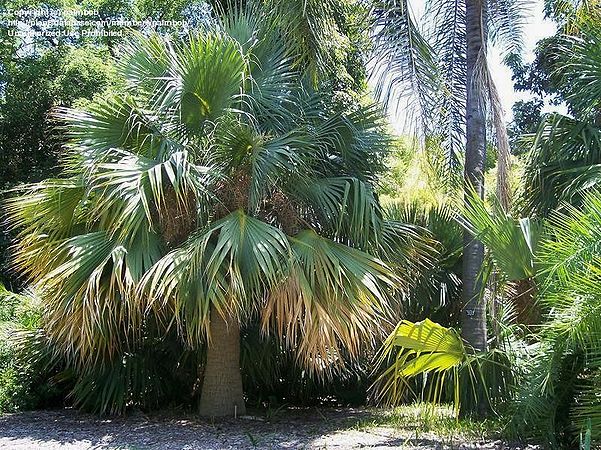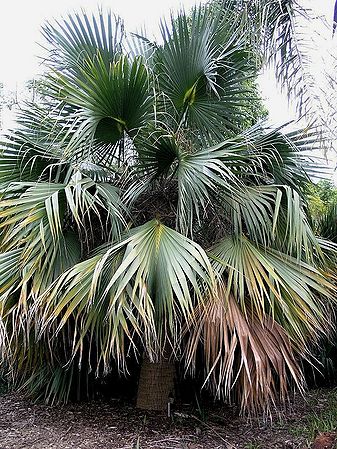Difference between revisions of "Sabal bermudana"
| Line 56: | Line 56: | ||
image:230e94.jpg|Los Angeles arboretum, CA. Photo by Geoff Stein. | image:230e94.jpg|Los Angeles arboretum, CA. Photo by Geoff Stein. | ||
image:6886e6.jpg|San Diego Botanic Garden, CA. Photo by growin. | image:6886e6.jpg|San Diego Botanic Garden, CA. Photo by growin. | ||
| − | image: | + | image:c535f6.jpg|San Diego Botanic Garden, CA. Photo by growin. |
image: | image: | ||
image: | image: | ||
Revision as of 01:33, 20 May 2014
Bermuda Palmetto
| Sabal (SAH-bahl) bermudana (behr-moo-DAHN-ah) | |||||||
|---|---|---|---|---|---|---|---|
|
Help to make this reference box better by uploading a representative photo of this palm. | |||||||
| Scientific Classification | |||||||
| |||||||
| Synonyms | |||||||
|
| |||||||
| Native Continent | |||||||
|
| |||||||
| Morphology | |||||||
| |||||||
| Culture | |||||||
|
| |||||||
| Survivability index | |||||||
|
| |||||||
| Common names | |||||||
|
| |||||||
Contents
Habitat and Distribution
Sabal bermudana is endemic to Bermuda. This tree is found island-wide in upland and coastal forests and freshwater marsh habitats. It does well in most situations and habitats, except the most salty, and makes a nice garden tree. This is the only palm species indigenous to Bermuda; all others were introduced.
Description
Sabal bermudana grows up to 25 m (82 ft) in height, with the occasional old tree growing up to 30 m (98 ft) in height, with a trunk up to 55 cm (22 in) in diameter. It is a fan palm (Arecaceae tribe Corypheae), with the leaves with a bare petiole terminating in a rounded fan of numerous leaflets. Each leaf is 1.5–2 m (4.9–6.6 ft) long, with 45-60 leaflets up to 75 cm (30 in) long. The flowers are yellowish-white, 5 mm (0.20 in) across, produced in large panicles up to 2.5 m (8.2 ft) long, extending out beyond the leaves. The fruit is a deep brown to black drupe about 1 cm (0.39 in) long containing a single seed. It is extremely salt-tolerant and is often seen growing near the Atlantic Ocean coast in Bermuda, and also frost-tolerant, surviving short periods of temperatures as low as -14 °C, although it will never get that cold in Bermuda. Editing by edric.
| read more |
|---|
Culture
A very easy and adaptable palm that will grow in temperate areas just as well as in the tropics and can take a good amount of frost and cold. Cold Hardiness Zone: 9a
Comments and Curiosities
Uses: Leaflets of the palm are used to weave hats, and export them to the United Kingdom and other countries. Sabal bermudana also had a hole drilled into its trunk, and the sap extracted to make "bibby", a strong alcoholic beverage. During the 19th century, most houses in Bermuda still had palmetto-thatched roofs.
Conservation: Listed as endangered. (IUCN Red List)
Bermuda Palmettos grow to 35 feet (10.5 m) high. The leaf stalk projects about halfway into the leaf in a V-shape which distinguishes it from the invasive Chinese Fan Palm. Also the leaf stalk of the Bermuda Palmetto never has spines or thorns. Bermuda Palmettos also have an attractive bright yellow patch around the stalk in the middle of the leaf. The dark green leaves are quite firm and hold up well in Bermuda’s windy weather.
They produce sprays of small yellowish white flowers in the spring. The fragrant flowers are pollinated by insects and mature into large clusters of fruit. These are round, bright green berries which become purplish black as they ripen in the autumn. Each berry contains a single large seed. The fleshy fruit of the Bermuda Palmetto provides food for a number of birds and other animals. The palmetto has a fibrous crown around the base of the leaves which provides habitat for insects and nesting material for birds.
Forests of Bermuda Palmetto once occurred in parts of Bermuda. Small surviving patches can be seen in nature reserves at Paget Marsh, and the Butterfield Nature Reserve in Point Shares. Palmetto forests provided important habitat for other endemic plants such as Bermuda Sedge, Bermuda Spike Rush, Campylopus moss and other rare plants like the native Psilotum. There is evidence that palmetto forests and mixed palmetto/cedar forests have occurred on Bermuda for thousands of years. Fossilized palm fronds can be seen on cliff faces at several sites along the coast, and fossilized roots and the holes created by palmetto stumps can be seen in rock formations around the island.
The Bermuda Palmetto is culturally a very important tree to Bermudians and has been exceptionally useful throughout the island’s 400 year history. The fibrous leaves of the Palmetto were historically used to make baskets, hats, fans, roof thatch and rope. The fruit of the Palmetto was used to make an alcoholic beverage called Bibey.
Today Bermuda Palmettos are frequently propagated and are available from most plant nurseries. They have been widely planted in parks and nature reserves, as well as in gardens, on golf courses and as street trees. (Government of Bermuda)
While generally similar to the closely related S. palmetto, this medium-sized, robust, stocky species, which is native only to the Island of Bermuda, forms a sturdy trunk that will rarely reach more than 10 m (33 ft.) tall. In addition, the broad, rigid leaf segments, the leaf blade split to only to about half its length, and the comparatively large, slightly pear-shaped fruits readily distinguish this palm. Sabal bermudana is still occasionally seen in cultivation under the names S. beccariana, S. princeps or S. blackburniana. (RPS.com)
- IMAGE GALLERY
External Links
- Glossary of Palm Terms
- MODERN BOTANICAL LATIN
- "Just To Be Clear"
- http://www.youtube.com/watch?v=aknKPgGheSg
- http://www.palmtalk.org/forum/index.php?/topic/35291-sabal-bermudana-or-sabal-causarium/
References
Phonetic spelling of Latin names by edric.
Special thanks to Geoff Stein, (Palmbob) for his hundreds of photos.
Special thanks to Palmweb.org, Dr. John Dransfield, Dr. Bill Baker & team, for their volumes of information and photos.
Glossary of Palm Terms; Based on the glossary in Dransfield, J., N.W. Uhl, C.B. Asmussen-Lange, W.J. Baker, M.M. Harley & C.E. Lewis. 2008. Genera Palmarum - Evolution and Classification of the Palms. Royal Botanic Gardens, Kew. All images copyright of the artists and photographers (see images for credits).
Many Special Thanks to Ed Vaile for his long hours of tireless editing and numerous contributions.












